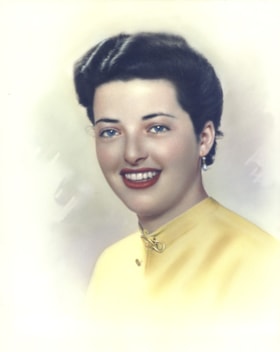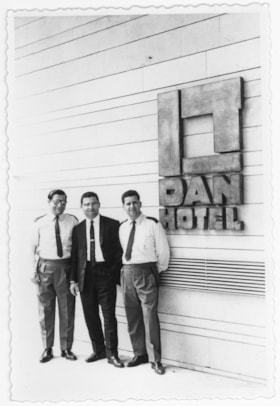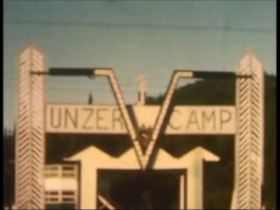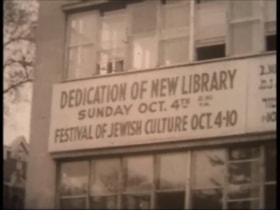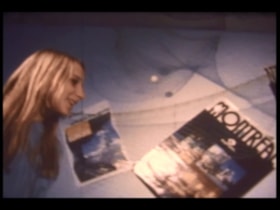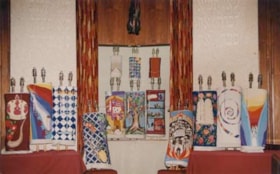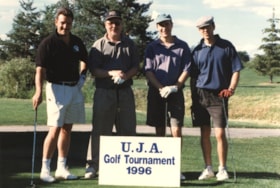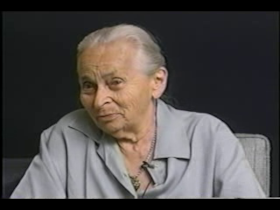Narrow Results By
Collection
- ABER, Ita 1
- CONGREGATION SHAAR HASHOMAYIM MUSEUM AND ARCHIVES 5
- Camp Kindervelt/Camp Unzer Collection 1
- Canadian Jewish Congress organizational records 1
- GOLD, Alan 1
- Henry Morgentaler and Gertrude Katz 1
- JEWISH IMMIGRANT AID SERVICES (JIAS) 1
- Jewish Public Library Historical Collection 1
- Moshe Sadeh collection 1
- NATIONAL COUNCIL OF JEWISH WOMEN (NCJW) 1
- Ottawa Jewish Community Council = Ottawa Vaad Ha'Ir = The Jewish Federation of Ottawa fonds 1
- WITNESS TO HISTORY COLLECTION (MHMC-02) 51
Place
- Amsterdam, Netherlands, Europe 1
- Bedzin, Poland, Europe 1
- Berlin - Charlottenburg, Germany, Europe 1
- Berlin-Charlottenburg, Germany, Europe 1
- Berlin, Germany, Europe 5
- Brno, Czech Republic (Czechoslovakia), Europe 1
- Brussels, Belgium, Europe 1
- Budapest, Hungary, Europe 2
- Crimmitschau, Germany, Europe 1
- Gera, Germany, Europe 1
- Hochheim am Main, Germany, Europe 1
- Iasi, Romania, Europe 1
Canadian Jewish Congress organizational records
https://www.cjhn.ca/link/cjhn2
- Collection
- Canadian Jewish Congress organizational records
- Description Level
- Fonds
- Material Type
- textual record
- graphic material
- sound recording
- moving images
- Physical Description
- Env. 361.57 metres of textual records. - Env. 14100 photographs. - 1531 sound elements. - 43 films. - 1017 videos.
- Fonds No.
- CJC0001
- Date
- 1765-present.
- Scope and Content
- The collection consists of several classes of material, as described in the series descriptions below. While the CJC materials begin in 1919, Series Z, the documentation collection, contains material that precedes this date, a few items going back even as far as the earliest settlement of Jews in C…
- Description Level
- Fonds
- Material Type
- textual record
- graphic material
- sound recording
- moving images
- Physical Description
- Env. 361.57 metres of textual records. - Env. 14100 photographs. - 1531 sound elements. - 43 films. - 1017 videos.
- Scope and Content
- The collection consists of several classes of material, as described in the series descriptions below. While the CJC materials begin in 1919, Series Z, the documentation collection, contains material that precedes this date, a few items going back even as far as the earliest settlement of Jews in Canada in the late 18th century.
- Date
- 1765-present.
- Fonds No.
- CJC0001
- History / Biographical
- Canadian Jewish Congress was founded in Montreal in March 1919. "The Parliament of Canadian Jewry," CJC was constituted as the democratically elected, national organizational voice of the Jewish community of Canada, serving as the community's vehicle for defence and representation. Committed to preserving and strengthening Jewish life, CJC acted on matters affecting the status, rights and welfare of the Canadian Jewish community, other Diaspora communities and the Jewish people in Israel. CJC combatted antisemitism and racism, promoted human rights, fostered interfaith, cross-cultural relations and worked towards tolerance, understanding and goodwill among all segments of society in a multicultural Canada. The organization spoke on a broad range of public policy, humanitarian and social-justice issues on the national agenda that affected the Jewish community and Canadian society at large. Through its charitable operations, CJC provided domestic and international relief aid on a non-sectarian basis, following natural disasters and to isolated Jewish communities in need. The Archives department also fell under the mandate of CJC Charities Committee. In 1999 the CJC national office relocated to Ottawa, with three regional CJC offices (Quebec, Ontario and Pacific), as well as affiliated offices across the country. CJC ceased operations in July 2011, when it was absorbed into the newly-created Centre for Israel and Jewish Affairs (CIJA), along with the Canada-Israel Committee, the Quebec-Israel Committee, National Jewish Campus Life and the University Outreach Committee. CJC and its charitable wing were formally disbanded in late 2015. Since that time the CJCCC National Archives, renamed the Alex Dworkin Canadian Jewish Archives as of January 2016, functions under the aegis of Jewish Federations Canada UIA.
- Custodial History
- Both the national headquarters and the Quebec Jewish Congress (formerly Quebec Region, Eastern Region) offices of the Canadian Jewish Congress were located in Montreal until 1999, when most of the national office relocated to Ottawa. The National Archives is the repository of records created and received in these offices. The collection also includes materials from the National Office in Ottawa, as well as the national records of Manuel Prutschi, Bernie Farber, and other national departments based in Toronto and Vancouver. The regional offices of Canadian Jewish Congress outside Quebec are little represented in the collection, aside from correspondence from across the country and certain publications which were addressed to the national office.
- Notes
- General note: The number of paper records in this collection is subject to change, due to additions to Documentation Series Z as well as the ongoing weeding of duplications. Most of the material was created after 1919, with the exception of Series Z, which includes photocopies and a small number of originals dating back as far as 1765.
- Archival / Genealogical
- Archival Descriptions
- Repository
- Canadian Jewish Archives
Images
NATIONAL COUNCIL OF JEWISH WOMEN (NCJW)
https://www.cjhn.ca/link/cjhn50
- Collection
- NATIONAL COUNCIL OF JEWISH WOMEN (NCJW)
- Description Level
- Fonds
- Material Type
- textual record
- graphic material
- sound recording
- moving images
- Physical Description
- 8.09 metres of textual records. - 1488 photographs. - 3 sound elements. - 3 discs. - 7 videos.
- Fonds No.
- I0048
- Date
- 1909-1990.
- Scope and Content
- National by-laws (1950, 1965, 1969). Resolutions (1961-1969). Administrative & financial records. Hotel facilities (1959-1965). Annual report (1970). Minutes (1955-1974 with gaps). Biennial reports and minutes (1950-1959). Correspondence. Year book (1944). Directory (1972-1973). Officers lists (194…
- Collection
- NATIONAL COUNCIL OF JEWISH WOMEN (NCJW)
- Description Level
- Fonds
- Material Type
- textual record
- graphic material
- sound recording
- moving images
- Physical Description
- 8.09 metres of textual records. - 1488 photographs. - 3 sound elements. - 3 discs. - 7 videos.
- Scope and Content
- National by-laws (1950, 1965, 1969). Resolutions (1961-1969). Administrative & financial records. Hotel facilities (1959-1965). Annual report (1970). Minutes (1955-1974 with gaps). Biennial reports and minutes (1950-1959). Correspondence. Year book (1944). Directory (1972-1973). Officers lists (1948-1949, 1973). Board member list (1971). Other membership lists. Pamphlets on International Council of Jewish Women. Biennial conventions (ICJW & NCJW). Minutes & information (1953-1973). Publications, flyers, invitations, seminar notes. Convention information, lecture notes and agendas. Gerontology conference notes (1968). Bulletin (1946). Magazines (1963-1973 with gaps). Programs & services materials (foster homes, Project Canada, School for Citizen Participation 1970), field service (1964-1965), workbooks, the elderly, National Theatre for Canada (1961-1963), overseas service (1954-1960), public affairs (1965-1967), leadership). Booklet on history of NCJW (1967). Material on "Canadian Women of the Century 1867-1967" (1967). Scrapbooks. Clippings (1940s-1990 and photocopies of 1909, 1912 articles). Photos, including slides of events, services, programs in Israel & Canada (1914-1975) - collection PC 3. Sound recordings of meetings and lectures (1950s-1970s).
- Date
- 1909-1990.
- Fonds No.
- I0048
- History / Biographical
- The National Council of Jewish Women was established in the United States in 1893, to help new Jewish immigrants. A Canadian branch began in Toronto in 1897. In Montreal the Baron de Hirsch Institute covered immigrant aid at that time, and the Montreal NCJW chapter was only founded in 1918. The International Council was formed in 1912. NCJW is dedicated to furthering human welfare in the Jewish and general community, locally, nationally, and internationally. They do and did so through scholarships, summer camps, libraries, aiding immigrants, volunteer work, pre-and post-war refugee aid, gerontology research, services to the elderly, support of the Golden Age Association, shipments of play and school materials to Israel and North Africa, lobbying for equal pay and other human rights bills, and opening a shelter for battered Jewish women. Their members across Canada and the world both fundraise and volunteer.The National office of NCJW Canada moved from Montreal to Toronto in the mid-1950s before settling in Winnipeg in the early 1990s where it remained until 2015.
- Custodial History
- The collection is divided into three parts: an original donation of material relating to the National office in Montreal and other locations up to 1978; National material donated in 2015 by the Winnipeg National headquarters office (1943-2009); and (see Series A) material relating to the Montreal Chapter office (1926-1999)
- Notes
- Alpha-numeric designations: MA 4, PC 3.
- Archival / Genealogical
- Archival Descriptions
- Repository
- Canadian Jewish Archives
Images
JEWISH IMMIGRANT AID SERVICES (JIAS)
https://www.cjhn.ca/link/cjhn16328
- Collection
- JEWISH IMMIGRANT AID SERVICES (JIAS)
- Description Level
- Fonds
- Material Type
- textual record
- graphic material
- sound recording
- moving images
- Physical Description
- Env. 376.3 metres of textual records. - 3250 photographs. - 123 sound elements. - 9 videodiscs.
- Fonds No.
- I0037
- Date
- 1920-1989.
- Collection
- JEWISH IMMIGRANT AID SERVICES (JIAS)
- Description Level
- Fonds
- Material Type
- textual record
- graphic material
- sound recording
- moving images
- Physical Description
- Env. 376.3 metres of textual records. - 3250 photographs. - 123 sound elements. - 9 videodiscs.
- Date
- 1920-1989.
- Fonds No.
- I0037
- History / Biographical
- Jewish Immigrant Aid Services was established during the first Plenary Assembly of the Canadian Jewish Congress, in 1919. The need to settle Jewish post-World War I immigrants became apparent at this time, but the community organizations established in part for this purpose, such as the Baron de Hirsch Institute, were overwhelmed by the flow of Jews into Montreal and the rest of Canada. Thus JIAS, an organization devoted solely to helping immigrants, was founded. Since 1919, Jewish immigrants to Canada have depended on this organization during their period of adjustment to this country. The JIAS intervenes with the government on behalf of current and prospective immigrants, helps to locate housing and jobs, and organizes language and citizenship classes. JIAS assists new immigrants in following the proper application procedures, provides counselling, and offers a directional service to community resources. JIAS also makes submissions to the authorities on all matters affecting Jewish immigration to Canada, jointly with the Canadian Jewish Congress. The national office moved from Montreal to Toronto in the 1990s. In 2008 the Montreal office of JIAS merged with two other Jewish social service agencies under the name Agence Ometz.
- Notes
- Alpha-numeric designations: MA 4.General note: As of 2017 the total amount of textual records in the JIAS collection is 376.3 metres, of which 66.3 metres are administrative records and 310 metres are case files. 192 metres of the case files are preserved in off-site storage.
- Archival / Genealogical
- Archival Descriptions
- Repository
- Canadian Jewish Archives
Images
ABER, Ita
https://www.cjhn.ca/link/cjhn285
- Collection
- ABER, Ita
- Description Level
- Fonds
- Material Type
- graphic material
- object
- moving images
- sound recording
- textual record
- Physical Description
- 13 photographs. - 4 artefacts. - 2 videos. - 1 compact disc (CD-ROM). - Env. 0.07 metres of textual records.
- Fonds No.
- P0184
- Date
- [ca. 1930]-2015.
- Scope and Content
- Recipies Mother Never Knew Mizrachi-Hapoel, 1965. Glass milk bottle designed with input from Mrs. Aber's mother for Montreal's Milk Fund, pre-WWII. Pins and badges from Zionist groups and conventions, photos of the staff of Aid to Israel 1950, Aid to Israel Jewish Youth Group 1950, Zionist Organiza…
- Collection
- ABER, Ita
- Description Level
- Fonds
- Material Type
- graphic material
- object
- moving images
- sound recording
- textual record
- Physical Description
- 13 photographs. - 4 artefacts. - 2 videos. - 1 compact disc (CD-ROM). - Env. 0.07 metres of textual records.
- Scope and Content
- Recipies Mother Never Knew Mizrachi-Hapoel, 1965. Glass milk bottle designed with input from Mrs. Aber's mother for Montreal's Milk Fund, pre-WWII. Pins and badges from Zionist groups and conventions, photos of the staff of Aid to Israel 1950, Aid to Israel Jewish Youth Group 1950, Zionist Organization of Canada 1949-1950. Material on the Jewish Child's Day Appeal. Clippings and ephemera re: Zionism, Child's Day, and actor William Shatner, a former Montrealer. 9 Photos of Montreal scenes. Material about Montreal's Talmud Torah, Jewish Artists at Congregation Shaar Hashomayim. Additions 2001: 2 photos (snapshots) of Camp Hashomer Hadati in Bronte, Ontario, Hebrew textbook and prayer book dated 1979, photo of a 9th-grade class of Baron Byng High School including Ita Aber, Clippings, 2 Videos. Additions post 2001 (passim): Articles written by Ita Aber, information about her artwork and recent exhibitions. Addition 2015: Autobiographical audio interview of Ita Herscovitch Aber recorded in New York January 9, 2015 by Renata Stein; WAV file, 56 minutes, provided on CD. Transcript of interview, done by her daughter Mindy Aber Barad via email correspondence from Israel, 30 pages. Themes covered in the interview include her early life in Montreal, art education at Baron Byng high school with teacher Ann Savage, religious background, mother's involvement in charitable efforts such as the Milk Fund, help given to a German Jewish internee and a Jewish refugee, Ita Aber's work for the Israeli consulate in Montreal in the early 1950s, her establishment in New York circa 1953, her career as a textile artist, encounters with Martin Luther King, and Judy Chicago, art groups such as the Pomegranate Guild, Jewish motifs in artwork.
- Date
- [ca. 1930]-2015.
- Fonds No.
- P0184
- History / Biographical
- Ita Aber was born in Montreal, in 1932 and grew up in a family dedicated to Zionist and charitable causes. She later moved to New York, where she made her name as an artist. As described in a 2001 article; "Ita Aber is an artist who delights in unconventional formats that provide unique and startling insights into Jewish Life. Her work is found in almost every major Jewish museum throughout the world. She is a master of the fabric arts, which is by its very nature, an interdisciplinary field. As practiced by Ita Aber, the fabric arts explode in scale to include the diverse skills of embroidering, beadwork, sewing, appliqué, silkscreen, jewelry design, weaving, painting, sculpture, and assemblage. The stunning range of her talents is reflected in the vast array of work and Judaic objects she has produced, from wall hangings, jewelry, and sculpture to Torah covers, etrog boxes, and Purim masks." Ita Aber is also known as a conservator of textiles, an art historian, a curator, teacher, and the author of The Art of Judaic Needlework: Traditional and Contemporary designs (Scribner 1979).
- Custodial History
- This collection was donated by Mrs. Ita Aber.
- Notes
- Alpha-numeric designations: P01/12, P93/08, and subsequent additions (ongoing to P15/04.). Associated material: Clippings by and about Canadian-born journalist Sam Orbaum (1956-2002), a Jerusalem Post humour columnist (donated by Ita Aber and filed under his name.) General note: The biography is from an article published in The Artists Proof, Spring 2001.
- Archival / Genealogical
- Archival Descriptions
- Repository
- Canadian Jewish Archives
Images
Moshe Sadeh collection
https://www.cjhn.ca/link/cjhn101057
- Collection
- Moshe Sadeh collection
- Description Level
- Fonds
- Material Type
- textual record
- graphic material
- moving images
- Physical Description
- Env. 0.04 metres of textual records. - 137 photographs : 117 b&w, 20 col. - 1 compact disc (DVD-ROM) (movie).
- Fonds No.
- P0298
- Date
- 1946-2015.
- Scope and Content
- The collection includes Israeli documents and numerous photographs dating from 1946 through the 1960s attesting to Moshe Sadeh's experiences in the Palmach, the Israeli army, on kibbutz, in the Israeli Freemasons, and as an employee of the Dan Hotel, including its two year contract in Rangoon, Burm…
- Collection
- Moshe Sadeh collection
- Description Level
- Fonds
- Material Type
- textual record
- graphic material
- moving images
- Physical Description
- Env. 0.04 metres of textual records. - 137 photographs : 117 b&w, 20 col. - 1 compact disc (DVD-ROM) (movie).
- Scope and Content
- The collection includes Israeli documents and numerous photographs dating from 1946 through the 1960s attesting to Moshe Sadeh's experiences in the Palmach, the Israeli army, on kibbutz, in the Israeli Freemasons, and as an employee of the Dan Hotel, including its two year contract in Rangoon, Burma. The earliest photographs, from 1946, show life and friends in Abu Kir, a hachsharach / Zionist kibbutz training farm in Egypt. The Canadian documents and news articles relate to committee activities such as Magen David Adom, the Canadian Zionist Federation, the Sephardi Federation, and an Association of Egyptian-born Montrealers. There are also examples of letters to the editor and other writings, many of them autobiographical. A small notebook details Sadeh's impressions during a B'nai Brith trip to Germany led by Frank Diamant in the 1990s, on the theme of the country's refusal to grant citizenship to Turkish immigrants. Among the later photographs are numerous views of Montreal B'nai Brith events, as well as pictures of Moshe Sadeh with the mayor of Cote-St-Luc, and the Israeli Ambassador. A few pictures of Moshe and his wife Shelley, as well as pictures taken at his business are also included. There is 1 DVD reated by the USC Shoah Foundation: The Institute for Visual History and Education consisting of an interview with Moshe Sadeh (2015).
- Date
- 1946-2015.
- Fonds No.
- P0298
- History / Biographical
- Born in Egypt in 1928, Moshe (Maurice) Sadeh (originally Sadi, then Saadi) was from a Sephardic family that had immigrated from Smyrna, Turkey in the early 1920s. The family spoke Ladino, and then French, in Cairo. He trained for aliyah on a Hachsharah farm in Alexandria, and, after having illegally made aliya to the Land of Israel at the age of seventeen, served in the Palmach before and during the Israeli war of Independence. He served again in the Israeli army (IDF) from the early 1950s until 1955, when he began working for the Dan Hotel in Israel. He was co-founder of Kibbutz B'ror Ha'yil in the Northern Negev, whose group was formed by HeHalutz from Egypt. He later lived on a moshav. After immigrating to Montreal in 1964 he founded a textile import company. In Montreal he was active and on the executives of many Zionist and Jewish organizations in Montreal, among them Canadian Magen David Adom for Israel, the Zionist Federation, the Sephardi Federation, the B'nai Brith League of Human Rights, and AJOE (association des Juifs originaires d'Egypte). He was a frequent commentator on current affairs, particularly with regard to Israel and the Arab world. He died in Montreal in October 2018. (Biography based on details from Shelley Corrin and from his obituary in the Montreal Gazette, October 9, 2018.)
- Custodial History
- The collection was donated by Shelley Corrin, Moshe Sadeh's widow, on September 5, 2019
- Notes
- Alpha-numeric designations: P19/19.
- Archival / Genealogical
- Archival Descriptions
- Repository
- Canadian Jewish Archives
Images
Camp Kindervelt
https://www.cjhn.ca/link/cjhn78146
- Collection
- Camp Kindervelt/Camp Unzer Collection
- Description Level
- Fonds
- Material Type
- moving images
- Physical Description
- 1 film reel : col.
- Fonds No.
- 1357; 1357_001
- Date
- 1949-1954
- Collection
- Camp Kindervelt/Camp Unzer Collection
- Description Level
- Fonds
- Material Type
- moving images
- Physical Description
- 1 film reel : col.
- Date
- 1949-1954
- Fonds No.
- 1357
- Item No.
- 1357_001
- Storage Location
- 8-5A
- Notes
- Film capturing daily activities at Camp Kindervelt and Camp Unzer, between 1949-1954.
- Archival / Genealogical
- Archival Descriptions
- Repository
- Jewish Public Library Archives
Images
YouTube
Camp Kindervelt
https://www.youtube.com/embed/VeTryjsBiDUFilm, Dedication of the Jewish Public Library at 4499 avenue d'Esplanade
https://www.cjhn.ca/link/cjhn78143
- Collection
- Jewish Public Library Historical Collection
- Description Level
- Item
- Material Type
- moving images
- Physical Description
- 1 film : b&w
- Fonds No.
- 1000A; 1; 00001; 1000_00001
- Date
- October 4, 1953
- Collection
- Jewish Public Library Historical Collection
- Description Level
- Item
- Material Type
- moving images
- Physical Description
- 1 film : b&w
- Date
- October 4, 1953
- Fonds No.
- 1000A
- Series No.
- 1
- File No.
- 00001
- Item No.
- 1000_00001
- Storage Location
- Bay 1
- Creator
- Chanukas Habais Film
- Related Material
- Jewish Public Library Fonds
- Archival / Genealogical
- Archival Descriptions
- Repository
- Jewish Public Library Archives
Images
YouTube
Film, Dedication of the Jewish Public Library at 4499 avenue d'Esplanade
https://www.youtube.com/embed/1MLc3CVpShwMORGENTALER, Henry
https://www.cjhn.ca/link/cjhn88131
- Collection
- Henry Morgentaler and Gertrude Katz
- Description Level
- Series
- Material Type
- textual record
- graphic material
- moving images
- Physical Description
- Env. 0.2 metres of textual records. - 14 photographs. - 4 videos.
- Fonds No.
- P0260; a
- Date
- 1965-2005.
- Scope and Content
- Memoir typed by Gertrude Katz from cassette tapes recorded by Henry Morgentaler (tapes are at Library and Archives Canada). Printed documents including trial and appeal motions, facts about abortion in Canada, procedures manual for the Morgentaler abortion clinic. Two files of duplicate copies of d…
- Collection
- Henry Morgentaler and Gertrude Katz
- Description Level
- Series
- Material Type
- textual record
- graphic material
- moving images
- Physical Description
- Env. 0.2 metres of textual records. - 14 photographs. - 4 videos.
- Scope and Content
- Memoir typed by Gertrude Katz from cassette tapes recorded by Henry Morgentaler (tapes are at Library and Archives Canada). Printed documents including trial and appeal motions, facts about abortion in Canada, procedures manual for the Morgentaler abortion clinic. Two files of duplicate copies of documents in the Library and Archives Canada (then called the National Archives) collection and a finding aid to that collection, as well as correspondence with archivist Lawrence Tapper about the collection. Published articles by Morgentaler (some in magazines, some in pamphlet format) and newsclippings about him. One file of poems written by him. One file of chronological notes and typed impressions about his time in prisons in Quebec. One file of chronological details about the trials, including index cards with contact information for the lawyers involved. 14 photos (colour, 4" by 6"), of Morgentaler with Gertrude Katz and her husband Carl, H. Morgentaler with his second and third wives Carmen and Arlene, and Henry's sons (from eldest to youngest): Bamie (nickname for Abraham) (Chava's son); Yann (Carmen's son); and Benny (Arlene's son). Also a photograph of HM with Rod Dewar, a well-known and controversial commentator on CJAD. Several photographs of protests: one showing a long file of supporters in front of the Montreal courtroom while his first trial was on-going and other photos of women picketers holding posters in front of his Honore Beaugrand clinic. Video copy on two VHS cassettes of testimony HM recorded at the Shoah Foundation in Los Angeles, also video of the television movie "Choice - The Henry Morgentaler Story" (2005) and of "Life and Times" program broadcast on CBC about H.M.. Portion of the Choice script, with edits by Gertrude Katz. A few of the images used as illustrations in the Life and Times film: including a photograph of Aislin's "Allo Morgentaler?" cartoon about Mayor Drapeau in 1976, and a copy of Morgentaler's Polish exit visa. One book by Morrgentaler about abortion and three books about him and the court cases (two books in French, one in English). Book of stories by Chava Rosenfarb called "Survivors" and a copy of an in-depth article about her from the magazine Pakn-Trager.
- Date
- 1965-2005.
- Fonds No.
- P0260
- Series No.
- a
- History / Biographical
- Henekh /Henry Morgentaler was born in Poland in March 1923. As a youth during World War II he was imprisoned at the Lodz Ghetto and later at the Dachau concentration camp. After the war Morgentaler emigrated to Canada and entered medical practice, becoming one of the first Canadian doctors to perform vasectomies, to insert intrauterine devices, and to provide birth control pills to unmarried women. He opened his first abortion clinic in 1969 in Montreal, eventually opening eight clinics in cities across Canada, and training more than one hundred doctors. As a pro-choice advocate he fought numerous legal battles challenging the constitutionality of the federal abortion law; losing in 1975, but winning the second time, in 1988.In 2008, Morgentaler was awarded the Order of Canada 'for his commitment to increased health care options for women, his determined efforts to influence Canadian public policy and his leadership in humanist and civil liberties organizations.' Morgentaler died at the age of 90 in May 2013. (The Morgentaler details are abridged from the Wikipedia entry under his name.)
- Custodial History
- The collection was donated by Gertrude Katz on March 21, 2017
- Notes
- Alpha-numeric designations: P17/05a.Location of originals: A few papers are copies of or related to materials at Library and Archives Canada.Related groups of records: the Henry Morgentaler collection at Library and Archives Canada.
- Archival / Genealogical
- Archival Descriptions
- Repository
- Canadian Jewish Archives
Images
Sixty Years of Love
https://www.cjhn.ca/link/cjhn78144
- Collection
- Young Men's-Young Women's Hebrew Association
- Description Level
- Item
- Material Type
- moving images
- Physical Description
- 1 film : col., 761'
- Fonds No.
- 1256; 1256_0007
- Date
- ca. 1971
- Collection
- Young Men's-Young Women's Hebrew Association
- Description Level
- Item
- Material Type
- moving images
- Physical Description
- 1 film : col., 761'
- Responsibility
- Charles Lazarus
- Date
- ca. 1971
- Fonds No.
- 1256
- Item No.
- 1256_0007
- Storage Location
- JPL
- Language
- English
- Archival / Genealogical
- Archival Descriptions
- Repository
- Jewish Public Library Archives
Images
YouTube
Sixty Years of Love
https://www.youtube.com/embed/iB7TCaV6rboGOLD, Alan
https://www.cjhn.ca/link/cjhn75972
- Collection
- GOLD, Alan
- Description Level
- Fonds
- Material Type
- textual record
- graphic material
- moving images
- Physical Description
- 6.1 metres of textual records. - 40 photographs. - 2 videos.
- Fonds No.
- P0245
- Date
- 1985-2005.
- Scope and Content
- This collection reflects the everyday work of the Honourable Alan Bernard Gold, an important Quebec figure in his career as lawyer and judge. It also reflects his commitment to numerous professional and community organizations, as well as his passion for and patronage of classical music and reperto…
- Collection
- GOLD, Alan
- Description Level
- Fonds
- Material Type
- textual record
- graphic material
- moving images
- Physical Description
- 6.1 metres of textual records. - 40 photographs. - 2 videos.
- Scope and Content
- This collection reflects the everyday work of the Honourable Alan Bernard Gold, an important Quebec figure in his career as lawyer and judge. It also reflects his commitment to numerous professional and community organizations, as well as his passion for and patronage of classical music and repertory theatre. Most of the collection consists of speeches and correspondence. The 6.10 metres of textual records.in the collection include 13 large bound agenda books and 3 published books. The majority of the approximately 135 speeches are arranged together, although some appear in other files. The correspondence is mostly professional. The personal communication consists largely of letters of congratulation from family and friends for various judicial appointments and awards. The collection also includes minutes from various organizations, notes, court judgments, newspaper clippings, published interviews, event programs, event photographs, conference material, and some financial records and published books. There are 40 photographs and 2 VHS videocassettes of television coverage. The files are usually arranged in anti-chronological order.
- Date
- 1985-2005.
- Fonds No.
- P0245
- History / Biographical
- Due to his negotiating skills, Judge Alan B. Gold (OC, OQ) played an important role during several critical incidents in Quebec and Canadian history. He was involved in many Jewish community organizations as well as in the wider community. Born in Montreal on July 21, 1917, Alan Bernard Gold was the eldest of four children. His immigrant parents instilled in him a strong Jewish faith and identity, which his own son would later credit as the reason for his successful career. He received his B.A. from Queen's University in 1938, followed by his LL.L. in 1941 from Université de Montréal. He was called to the Bar of Quebec in 1942 but served with the Royal Canadian Artillery for the next four years. Upon his return to Montreal, Gold became an active member of the Bar of Quebec. In 1951 he was elected President of the Junior Bar; then in the years immediately following moved on to become a member of the Board of Examiners of the Bar, a founding director and officer of the Legal Aid Bureau and a leading barrister. From 1957 until 1971 he taught at the Faculty of Law of McGill University. In 1959 he was named Queen's Counsel, and in 1961, at the age of forty-four, he received his first judicial appointment, becoming a District Judge. In that capacity he was asked to serve as the first Vice-Chairman of the Quebec Labour Relations Board. In 1965, he was appointed Associate Chief Judge of the Provincial Court, and in 1970 he acceded to the post of Chief Judge of that Court (now renamed the Court of Quebec). As Chief Judge he served as President of the Quebec Judicial Council and Chairman of the Conseil du Référendum in 1980. In 1983, Alan Gold was appointed Chief Justice of the Superior Court of Quebec, remaining in this position until 1992. At the time, the Court struggled with severe delays and backlogs. Knowing that "justice delayed is justice denied", Judge Gold was successful in working to improve its efficiency. He saw his role as one of management, and several of his speeches are titled "Le Juge en chef, gestionnaire de la Cour supérieure". After retiring from the Bench in 1992 at the mandatory age of seventy-five, Gold moved on to the field of private-sector dispute resolution as a full-time arbitrator and mediator. He took the position as Senior Counsel to the firm of Davies Ward Phillips & Vineberg LLP, and was the chair of their Department of Alternative Dispute Resolution until his death. Throughout his long career, even while on the Bench, he was "most famed as an arbitrator and mediator" of public sector and para-public sector disputes. He acted in numerous well-known national and provincial cases, most notably involving Canadian ports, railways, airlines, and the Post Office. As an arbitrator he helped avoid a strike by the longshoremen at the Port of Montreal in 1968. In 1990, he negotiated a settlement between the Quebec government and the Mohawk people in the Oka standoff, and in 1993, he negotiated a settlement at Nationair, bringing the 16 month-long Lockout of its Flight Attendants to an end. Also in 1993 he represented the government of Saskatchewan in negotiating a settlement in the wrongful conviction of David Milgaard and reviewed the out-of-court settlement between former Prime Minister Brian Mulroney and the federal government in Mulroney's anti-defamation suit in the alleged Airbus affair. He served as Chairman of the Bar of Montreal's committee on access to justice in the English language in the judicial district of Montreal whose Report was submitted on March 31, 1995. Among his non-juridical activities, he was Chairman of McGill University, Chancellor of Concordia University and Associate Governor of the University of Montreal. In addition to his dedication to the cause of higher education, he was involved in the arts (Place des Arts, I Musici) and in the Montreal Jewish community (e.g.: Montreal Holocaust Centre, Federation CJA). He was also a founding member of the Society of Professionals in Dispute Resolution (USA). Over his career he received numerous honourary degrees, medals and other recognition; notably, in 1995 he was made an Officer of the Order of Canada in 1995, and an Officer of the L'Ordre National du Québec in 1985. In 1991, he received the Médaille du Barreau du Québec, and in 1997 he was named a member of the Académie des Grands Montréalais for his many contributions to the cultural and social life of the City. Five universities bestowed honourary doctorates upon him, including Yeshiva University in 1987, and in 1996 he was made an Honourary Life Member of the National Academy of Arbitrators (USA). In 1992, he was awarded the Canadian Jewish Congress' Samuel Bronfman Medal, and in 1998, he was the recipient of the Tel-Aviv University President's Award. In 1949, he married Lynn Lubin and they had three children: Marc, Nora and Daniel. They were long-time members of Shaare Zedek Congregation in Montreal. He died on May 15, 2005 at the age of eighty-seven. Sources: Abridged biography by Alan Gold, Sept. 2001 (in collection); Recueil bibliographique des membres de l'Ordre national du Québec 1985 and 1997; Wikipedia entry http://en.wikipedia.org/wiki/Alan_B._Gold,; http://www.parl.gc.ca/Content/Sen/Chamber/381/Debates/061db_2005-05-17-e.htm#12., http://www.droit.umontreal.ca/doctorat/prix_bourses/bourse_alan_b_gold.html.
- Custodial History
- The collection was donated by Marc Gold in May 2010.
- Notes
- Alpha-numeric designations: P11/13, MC 33.
- Archival / Genealogical
- Archival Descriptions
- Repository
- Canadian Jewish Archives
Images
New Torah Covers for Congregation Shaar Hashomayim
https://www.cjhn.ca/link/cjhn44506
- Collection
- CONGREGATION SHAAR HASHOMAYIM MUSEUM AND ARCHIVES
- Description Level
- Item
- Material Type
- moving images
- Physical Description
- Video : VCR tape : English : duration: 1 min 19 sec
- Fonds No.
- SH-01; 313
- Date
- 1995
- Description Level
- Item
- Material Type
- moving images
- Physical Description
- Video : VCR tape : English : duration: 1 min 19 sec
- Date
- 1995
- Fonds No.
- SH-01
- Item No.
- 313
- Physical Condition
- Good
- Notes
- A video showing the 14 needlepoint Torah covers that were made by women from the Shaar Hashomayim in honour of the synagogue’s 150th anniversary. The covers were made for a Jewish artists competition organized by Mrs. Millie Lande.
- Places
- Montreal, Quebec, Canada
- Archival / Genealogical
- Archival Descriptions
- Repository
- Congregation Shaar Hashomayim Museum and Archives
Images
YouTube
New Torah Covers for Congregation Shaar Hashomayim
https://www.youtube.com/embed/WJRnbik1mvAPresentation of a Coat of Arms for Congregation Shaar Hashomayim
https://www.cjhn.ca/link/cjhn44507
- Collection
- CONGREGATION SHAAR HASHOMAYIM MUSEUM AND ARCHIVES
- Description Level
- Item
- Material Type
- moving images
- Physical Description
- Video : VCR tape : English : duration: 1 min 21 sec
- Fonds No.
- SH-01; 315
- Date
- 1995
- Description Level
- Item
- Material Type
- moving images
- Physical Description
- Video : VCR tape : English : duration: 1 min 21 sec
- Date
- 1995
- Fonds No.
- SH-01
- Item No.
- 315
- Physical Condition
- Good
- Notes
- In this video the Shaar Hashomayim receives a coat of arms.
- Places
- Montreal, Quebec, Canada
- Archival / Genealogical
- Archival Descriptions
- Repository
- Congregation Shaar Hashomayim Museum and Archives
Images
YouTube
Presentation of a Coat of Arms for Congregation Shaar Hashomayim
https://www.youtube.com/embed/tjzDMBSzkkACongregation Shaar Hashomayim's Programs for Elderly People
https://www.cjhn.ca/link/cjhn44497
- Collection
- CONGREGATION SHAAR HASHOMAYIM MUSEUM AND ARCHIVES
- Description Level
- Item
- Material Type
- moving images
- Physical Description
- Video : English : duration: 28.67 seconds
- Fonds No.
- SH-01; 222
- Date
- 2001
- Description Level
- Item
- Material Type
- moving images
- Physical Description
- Video : English : duration: 28.67 seconds
- Date
- 2001
- Fonds No.
- SH-01
- Item No.
- 222
- Physical Condition
- Excellent
- Notes
- "The Open Gate" is a weekly socializing program for the elderly, organized by the Congregation.
- Places
- Montreal, Quebec, Canada
- Archival / Genealogical
- Archival Descriptions
- Repository
- Congregation Shaar Hashomayim Museum and Archives
Images
YouTube
Congregation Shaar Hashomayim's Programs for Elderly People
https://www.youtube.com/embed/fZ6e_IpxxtcReverend David Wolfson speaks of activities at the Congregation Shaar Hashomayim
https://www.cjhn.ca/link/cjhn44502
- Collection
- CONGREGATION SHAAR HASHOMAYIM MUSEUM AND ARCHIVES
- Description Level
- Item
- Material Type
- moving images
- Physical Description
- Video : VCR tape : English : duration: 1 minute 3.07 seconds
- Fonds No.
- SH-01; 228
- Date
- 2001
- Description Level
- Item
- Material Type
- moving images
- Physical Description
- Video : VCR tape : English : duration: 1 minute 3.07 seconds
- Date
- 2001
- Fonds No.
- SH-01
- Item No.
- 228
- Physical Condition
- Excellent
- Notes
- Reverend Wolfson organizes weddings, Bar Mitzvahs, etc. at the Shaar Hashomayim. This video contains a short interview with a masgiach (kashruth inspector) in training and a glimpse of a musical group for youths.
- Places
- Montreal, Quebec, Canada
- Archival / Genealogical
- Archival Descriptions
- Repository
- Congregation Shaar Hashomayim Museum and Archives
Images
YouTube
Reverend David Wolfson speaks of activities at the Congregation Shaar Hashomayim
https://www.youtube.com/embed/ZYfCBkYrZTgArtist Terry Lightman
https://www.cjhn.ca/link/cjhn44508
- Collection
- CONGREGATION SHAAR HASHOMAYIM MUSEUM AND ARCHIVES
- Description Level
- Item
- Material Type
- moving images
- Physical Description
- Video : DV tape : English : duration: 1 min 22 sec
- Fonds No.
- SH-01; 320
- Date
- 2002
- Description Level
- Item
- Material Type
- moving images
- Physical Description
- Video : DV tape : English : duration: 1 min 22 sec
- Date
- 2002
- Fonds No.
- SH-01
- Item No.
- 320
- Physical Condition
- Excellent
- Notes
- Interview with artist Terry Lightman, a long-time curator of the Congregation Shaar Hashomayim Museum and Library. Many of her works are shown in this video clip.
- Places
- Montreal, Quebec, Canada
- Archival / Genealogical
- Archival Descriptions
- Repository
- Congregation Shaar Hashomayim Museum and Archives
Images
YouTube
Artist Terry Lightman
https://www.youtube.com/embed/wJtC9LLn6DQDVD of photographs of the 77th Annual General Meeting of the Jewish Federation of Ottawa.
https://www.cjhn.ca/link/cjhn105991
- Collection
- Ottawa Jewish Community Council = Ottawa Vaad Ha'Ir = The Jewish Federation of Ottawa fonds
- Description Level
- Item
- Material Type
- moving images
- Fonds No.
- O0043; OJA 18-169
- Date
- June 1 2011
- Collection
- Ottawa Jewish Community Council = Ottawa Vaad Ha'Ir = The Jewish Federation of Ottawa fonds
- Description Level
- Item
- Material Type
- moving images
- Date
- June 1 2011
- Fonds No.
- O0043
- Item No.
- OJA 18-169
- Storage Location
- Multimedia Box 1
- Creator
- Peter Waiser
- Notes
- Ian Sherman received the Gilbert Greenberg Distinguished Service Award, Morris Kimmel received the Shem Tov Community Volunteer award and Lisa Miller received the Freiman Family Young Leadership award.Annual General Meeting was held at the Soloway Jewish Community Centre.
- Archival / Genealogical
- Archival Descriptions
- Repository
- Ottawa Jewish Archives
Images
Goldberg, Peter - Oral History of a Holocaust Survivor
https://www.cjhn.ca/link/cjhn60297
- Collection
- WITNESS TO HISTORY COLLECTION (MHMC-02)
- Description Level
- Item
- Material Type
- moving images
- Physical Description
- 00:59:33
- Collection
- WITNESS TO HISTORY COLLECTION (MHMC-02)
- Description Level
- Item
- Material Type
- moving images
- Physical Description
- 00:59:33
- Language
- English
- Notes
- Peter Goldberg was born on May 12, 1919 in Paberze, a village approximately 20 km from Vilnius, Lithuania (Vilna, Poland), where he and his nine siblings were raised in an orthodox Jewish home. The Russian Army occupied Vilnius in 1939 until the Germans took over in 1941. Peter recalls the many restrictions placed on Jews, including the wearing of yellow stars, forced labour, and the establishment of the Jewish ghetto. Peter and his wife had to stay in the ghetto for about seven months. They remained there, often in hiding, until it was liquidated by the German Gestapo. Then, for ten months, they paid to live in a Polish house approximately 10 km from the Ghetto. Peter was taken to do forced labour as a coal digger in Bielawaka ? concentration camp. Once the camp was liquidated, he and his wife had to return to the ghetto in Vilnius for a second time until it closed in 1943. They spent about eight months in the Vilnius HKP-562 concentration camp where Peter was forced to work as a mechanic. The Germans liquidated the camp in July 1944. After liberation by the Russian Army, he and his wife returned home. He knew that most of his family had been killed immediately upon arrival in the ghetto in Vilnius (Vilna). After the war, Peter worked as a baker and a stock keeper of food for the Russian Army. When the borders opened in 1957, Peter, his wife and their daughter immigrated to Poland. They lived there until December 1958 when they decided to immigrate to Canada, as Peter’s sister was living in Montreal. Once here, Peter worked as a butcher and manager of a meat store.
- Accession No.
- WTH-050
- Name Access
- Goldberg, Peter
- Archival / Genealogical
- Archival Descriptions
- Repository
- Montreal Holocaust Museum
Images
YouTube
Goldberg, Peter - Oral History of a Holocaust Survivor
https://www.youtube.com/embed/kd0CWEt_QrcRosen, Chaim - Oral History of a Holocaust Survivor and WWII Veteran
https://www.cjhn.ca/link/cjhn60298
- Collection
- WITNESS TO HISTORY COLLECTION (MHMC-02)
- Description Level
- Item
- Material Type
- moving images
- Physical Description
- 01:44:56
- Collection
- WITNESS TO HISTORY COLLECTION (MHMC-02)
- Description Level
- Item
- Material Type
- moving images
- Physical Description
- 01:44:56
- Language
- English
- Notes
- Chiam Rosen was born on December 7, 1918 in the small Polish town of Tomaszow Mazowiecki, to a father who was a ritual slaughterer/cantor/Hebrew teacher and a mother who was a housewife. When he was two, he moved to Magdeberg, Germany. His two brothers were born there, one in 1920 and the other in 1924. He began school in Madgeberg and finished, after another move, in Braunschweig, where he lived until the war broke out. In 1933 he and his brother were kicked out of school. His father took him to a cabinet-maker, where he became an apprentice. He worked there for 3.5 years. When he turned 18 he realized Germany was not the place for him and he obtained a Pioneer Certificate. He was given a certificate to go to Palestine. When he left in July 1937 he was seeing his parents for the last time. He made his way to Palestine via Italy. When he arrived he joined a kibbutz, building defense walls before working as a mounted police defending the towns. Eventually he joined the Palestinian army, was trained under the British army, and served in artillery groups. He was sent to Italy and there he received news of his brothers, both of whom had also joined the army, and his parents, who had been transported to the Warsaw (or Lodz) ghetto. Once the war was over Chiam went from Italy to Austria to Germany and Belgium, helping prisoners from DP camps, bringing food, transporting supplies and trying to help orphaned children. He visited Bergen-Belsen, not as part of the army but with a group of people who wanted to help. Eventually he was discharged and returned to Palestine. On the way he was reunited with one of his brothers. In Palestine he helped in preparation for the Israeli War of Independence, but did not fight in it. He and his brothers contacted their uncle who was living in Montreal, Canada. They were granted visas and emigrated to Montreal. Eventually they moved to Quebec City to work in the scrap metal business. Chiam married in 1954 in Canada. They separated after 40 years with no children.
- Accession No.
- WTH-060
- Name Access
- Rosen, Chaim
- Archival / Genealogical
- Archival Descriptions
- Repository
- Montreal Holocaust Museum
Images
Kipman, Stella - Oral History of a Holocaust Survivor
https://www.cjhn.ca/link/cjhn60299
- Collection
- WITNESS TO HISTORY COLLECTION (MHMC-02)
- Description Level
- Item
- Material Type
- moving images
- Physical Description
- 01:41:29
- Collection
- WITNESS TO HISTORY COLLECTION (MHMC-02)
- Description Level
- Item
- Material Type
- moving images
- Physical Description
- 01:41:29
- Language
- English
- Notes
- Stella Kipman (née Ginsburg) was born on January 14, 1918 in Slomniki, Poland. Her family moved to Krakow where she completed her education. After marrying, Stella and her husband moved to Sosnowiec. In 1939, about a year and a half after marrying and moving to Sosnowiec, the war broke out and Stella returned to her father in Krakow. She went back to Sosnowiec where she got a job in social service. Stella and her husband were forced to live in the Sosnowiec ghetto; she speaks of how difficult life was during this time, including the many restrictions and being forced to wear a band and yellow star. Between 1943 and 1944, Stella was sent to Katowice labour camp. In January 1944, Stella and her older sister obtained false papers and went to Berlin where she stayed with a housekeeper. However, she was soon discovered and put into prison by German Gestapo to work for several months. Afterwards, they sent her to Birkenau-Auschwitz to clean rooms and cook. In January 1945, Stella and many other camp inmates were sent by transport to a Polish barrack in Ravensbrück. Six weeks before liberation by the French Army, Stella lost consciousness due to a terrible fever – the Polish women in her barracks took care of her because she was the wife of a Polish officer. After liberation, she was taken to a hospital to recover and later returned to Sosnowiec by train. In December 1945, she was flown by a military plane to Paris and from there went to Freiburg for 18 months. Stella and her husband immigrated to Canada in 1951, followed by her only surviving sister.
- Accession No.
- WTH-074
- Name Access
- Kipman, Stella
- Places
- S?omniki, Poland, Europe
- Archival / Genealogical
- Archival Descriptions
- Repository
- Montreal Holocaust Museum
Images
Hiess, Anna - Oral History of a Holocaust Survivor
https://www.cjhn.ca/link/cjhn60300
- Collection
- WITNESS TO HISTORY COLLECTION (MHMC-02)
- Description Level
- Item
- Material Type
- moving images
- Physical Description
- 01:04:39
- Collection
- WITNESS TO HISTORY COLLECTION (MHMC-02)
- Description Level
- Item
- Material Type
- moving images
- Physical Description
- 01:04:39
- Language
- English
- Notes
- Anna Hiess (née Fliesser) was born in Vienna, Austria on April 12, 1914. Her family moved to Lemberg in 1918, after Anna’s father’s death. They were an assimilated family and did not experience discrimination before 1938, with the exception that they could not study wherever and whatever they wanted. Anna married in 1938. She left Lemberg with her husband in 1941, shortly after the German invasion. They went to Hrubieszow where they stayed a few months under false identity, leaving when people started to suspect they were Jews. They moved to Garwolin by train where they were helped by Stanislaw Piaskowski and the underground that provided them with a place to live and ration cards. Anna’s job was to conceal the forbidden radio while her husband worked in the income tax department. After the war, they moved to Lodz and started a new life with their son. The family immigrated to Israel in 1950 because Anna’s husband was in danger since he got involved in politics. They were disappointed when they arrived in Tel-Aviv and felt hostility coming from Jews who had lived in Israel since before the war. They decided to immigrate to Montreal in 1952, sponsored by a Canadian family they never met.
- Accession No.
- WTH-086
- Name Access
- Hiess, Anna
- Places
- Vienna, Austria , Europe
- Archival / Genealogical
- Archival Descriptions
- Repository
- Montreal Holocaust Museum
Images
{{ server.message }}




